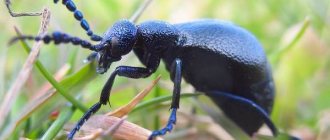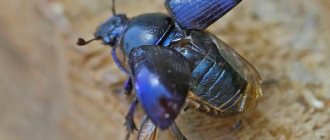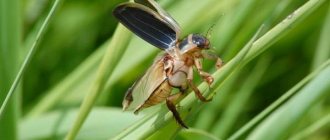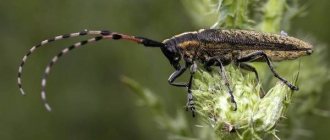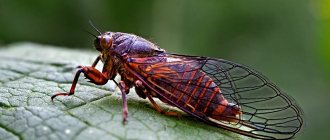The ground beetle is another prominent representative of the insect family, which can cause some harm to humans by destroying food, as well as grain crops. However, not all types of ground beetles are considered harmful: there are also beneficial insects of this species. The insect often appears in a person’s home, causing significant damage to food products, as well as to the premises. Everyone who encountered this pest thought about how to get rid of this insect.
This article explains what the beetle looks like and how to get rid of it using various methods.
Description
Ground beetles are large (usually around 15 mm long) individuals, with individual specimens reaching an incredible five cm in length - if not more.
The body of this beetle is usually elongated, with various variations of shades from dark black to brown, even sometimes with a metallic or pearlescent tint. The wings of these beetle species are typically grooved and decorated with brightly colored tiny dots.
Given their size, it is not surprising that these insects do not fly very well (and some of them cannot do it at all!) - they mainly use flights exclusively for settlement.
The ground beetle family is diverse in size - from a couple of millimeters to ten centimeters and has a wide variety of colors.
Characteristic features of this family are strong legs, bulging eyes and an unusual mouthparts equipped with powerful mandibles.
Phylogeny
Phylogenetic tree of the ground beetle family (after DR Maddison et al., 1999)
Ground beetles are closely related to the trachypachidae family (Trachypachidae CG Thomson, 1857), with which they have common ancestors. Regarding the intrafamily relationships of ground beetles, there are significant differences between different scientists and scientific schools, which is also reflected in the taxonomy of the family. The study of phylogenetic relationships using 18S ribosomal DNA sequencing methodology shows some nuances of the relationship of different groups of ground beetles. According to research, the oldest branches of the family are the subfamilies Carabinae and Siagoninae, which are located separately from other groups. From a common ancestor comes a group of subfamilies: Nebriinae, Loricerinae, Omophroninae, Psydrinae, Promecognathinae and Apotominae. The subfamily of bighead ground beetles (Broscinae) is close to them, however, it is located somewhat apart and is more evolutionarily developed. A separate group consists of the subfamilies Patrobinae and Trechinae, which are relatively young and developed from a common ancestor. The most specialized and evolutionarily developed of these is the scarita subfamily (Scaritinae). A completely different group of the family consists of the most evolutionarily progressive subfamilies of psidrins (Psydrinae), brachininae (Brachininae) and harpalinae (Harpalinae), and psidrins are much more isolated from the last two.
Big-headed ground beetle
Types of ground beetles
Ground beetles are distinguished by their extraordinary size, including being one of the largest families, which includes many genera and species, the classification of which is quite difficult.
Therefore, usually many features are used to diagnose and classify the species of these insects - from color and shape of the structure, structure, and even chaetotaxy (arrangement of bristles).
For example, the fauna of our country includes 15 subfamilies of this family, which, in turn, are divided into 40 tribes, almost 200 genera and almost 2 thousand species - and this accounts for about 5% of the entire world fauna of these insects.
Such a huge number of species and insects are usually divided into three large groups:
- Phytophagous
This small part is engaged in the destruction of cultivated plants - and significantly complicates the management of agricultural farming (including private ones). Usually in this case we are talking about a species such as the grain ground beetle - a resin-colored beetle of large size - about 1.5 cm. These beetles feed on cereal grains - wheat, barley and many other cultivated plants.
Bread ground beetle
- Entomophages
This is a useful ground beetle, but also a formidable predator. It benefits by eating many harmful insects that cause damage to agriculture.
- Mixophages (for example, millet ground beetle).
The beetles included in this group eat mainly plant foods, but sometimes they also happily consume food of animal origin when the diet is still significantly limited.
The system of ground beetle forms includes a separate classification in connection with the type of food, as well as depending on the habitat layer and even the type of movement.
Millet ground beetle
Other examples of ground beetles that we wrote about earlier
Caucasian ground beetle
Hungarian ground beetle
Gebler's ground beetle
Characteristics and body structure
The sizes of ground beetles range from 3 to 60 mm. Unlike other beetles, these ones fly poorly, but run fast. Some species do not fly at all. Ground beetles are long-lived; under favorable conditions they live 5 years, the average life expectancy is 3 years. It has many features in its body structure.
Head
The head is extended forward. Beetles have powerful and sharp jaws. Their shape is different, depending on what is included in the insect’s diet. Predatory species have a long, sickle-shaped upper jaw that helps them hold onto prey tightly. And insects that feed on plants have large and blunt jaws.
In some species the temples are clearly defined and the head is narrowed. The forehead is slightly compressed in front. If the compressed part is short and wide, it is called a fossa in the forehead; if it is long, it is called a groove. In front, the grooves fall on the clypeus, and in the back - on the temples.
The eyes of beetles have different sizes:
- large (active during the daytime and twilight);
- medium (nocturnal);
- small or absent (live in caves and inside the soil).
The upper lip can be hidden under the clypeus. Near the lower lip at the base of the chin there are 2 holes that help the individual hear. The antennae look like a thread and are clearly visible. The various segments are provided with bristles. Some antennae are bare, while others have small hairs.
Thoracic part
Depending on where the ground beetle lives, the shape of its pronotum will look different. If the pronotum is narrowed towards the base, it means that the front part of the body is highly active. Burrowing beetles have a constricted body shape, like an ant. The back of the back is well developed. In some species that live in caves, the scutellum may be small or absent.
Limbs
These insects are adapted to fast walking and running, so their legs are long, although thin. In burrowing species, the legs are thicker and have serrations. The acetabular ring is well developed. The trochanters are sometimes longer than the femurs. The antennae are cleaned using a notch on the front of the shins. Epiphytic individuals have a deep notch on the tarsi where the claw segment is inserted. It helps them grasp plants. Cave individuals have a process on this segment that helps them climb the walls of caves.
Wings and elytra
The degree of development of the wings depends on the species. The shape of the wings may depend on which gene is dominant. Flightless individuals with short wings live on islands, mountains and caves. The wings are used quite successfully by thermophilic and arboreal ground beetles of tropical species. Most of them fly so well that this is their main mode of transportation. Other beetles that fly poorly use their wings only during the dispersal process.
Hard elytra almost completely cover the ventral part. In species that do not have wings, they grow together. There are 9 longitudinal grooves on the surface.
Abdomen
Depending on the group, the abdominal cavity has 6-8 sternites. The male organ is asymmetrical and lies on its side at rest. On the surface there is a film and sclerites along all sides. There is no exact description of the parameters that will suit all types; each of them is individual.
Red Book
Ground beetles are one of the numerous families (if not the largest), the number of species of which ranges from 50 thousand species, which are replenished annually. And some of them are listed in the Red Book - such as, for example, the Crimean ground beetle. Its number is directly related to the amount of precipitation - it is they that regulate the volume of the food supply of this insect, which includes terrestrial mollusks. Its numbers are declining due to a decrease in areas of virgin soil, as well as an increase in the use of pesticides.
Crimean ground beetle
Nutrition
Ground beetles (the vast majority of them) are predators whose diet consists of a wide variety of invertebrate species. And in the evening they begin to hunt caterpillars and worms, not disdaining slugs and even snails. Possessing powerful jaws, ground beetles easily open chitinous shells and even shells.
Moreover, most ground beetles are characterized by extraintestinal digestion: in this case, the prey is exposed to gastric juice secreted using the beetle’s special filtering apparatus. But the ground beetle itself does not have poisonous qualities.
Larvae feed in the same way as adults, but sometimes they differ in their specialization - for example, they feed on earthworms or parasitize other insects.
Some ground beetles can be frog hunters.
The frog has no chance against the Epomis ground beetle - video
Horse
Jumping beetles
Another genus of garden ground beetles. A distinctive feature of the horses is a wide head and rather sharp protruding jaws. The beetles have variegated colors. They are active during daylight hours, quickly moving along the ground in search of food. In moments of danger they can fly short distances.
Interesting!
For all its elegance, the ground beetle is a predator. It feeds on caterpillars, snails, slugs, as well as leaf rollers and other pests. During the season, one individual is capable of destroying more than 300 pests.
Development and reproduction
In the development of this beetle, it is customary to distinguish four types of rhythm:
- Spring reproduction is when the larvae reach the size of an adult by winter, and thus overwinter.
- Summer reproduction - when wintering takes place in the larval stage;
- Winter reproduction is when summer hibernation ends.
- Variable reproduction, when development occurs in a variety of stages.
Typically, the development of a ground beetle takes about a year. The ground beetle begins to reproduce after reaching this age, when it reaches the adult stage.
The ground beetle is a representative of the Coleoptera - their development cycle refers to a complete transformation, which includes the passage of four stages:
- egg;
- larva;
- chrysalis;
- imago (full-fledged individual).
The mating season for ground beetles occurs at very different times of the year - and after mating, the female lays eggs. They are usually small in size and look like a cylinder with rounded ends with a thin shell of a whitish hue, through which the larva is already visible in the last stages.
Usually there are about two hundred eggs in a clutch - and their development period is about a month, and then larvae are born, living in the upper layers of the soil, consuming leaves of cereals.
Corn ground beetle larva
In the spring, the larva pupates (usually this also takes about a month), and already turns into a full-fledged insect.
The best means of protection against such insects is to shorten the harvesting time, along with the use of thorough removal of straw from fields and timely peeling of stubble. Plowing will not be superfluous either.
Chemical protection
Adults have a pair of pygidium glands at the end of the abdomen, which secrete a protective secretion if the beetle is disturbed. The composition of the substances released varies significantly among different species - various organic acids, quinones, hydrogen peroxide and many others.
Krasotel fragrant
Chemical defense has reached the greatest perfection in bombardier beetles (subfamily Brachininae). In case of danger, they point their abdomen towards the attacker and release a stream of irritating hot liquid, accompanied by a clearly audible sound, hence their name. The "shot" is achieved by mixing two inactive ingredients in a heavily sclerotized chamber at the end of the abdomen. The ingredients react explosively, bursting out under pressure and reaching temperatures of up to 100°C. Similar means of defense by explosion have also evolved independently in the subfamily Paussinae.
Bombardier crackling
The importance of ground beetles in nature
The overwhelming majority of ground beetles are polyphagous predators, which, combined with high numbers, largely determines their practical importance. Due to the lack of a decisive dependence on the density of the pest, ground beetles can stop the increase in the number of the pest even before the latter reaches the threshold of harmfulness. The complexity of breeding will probably never allow the use of the flood release method, the method of seasonal colonization, etc. for beneficial ground beetles, but the use of gentle plant protection products, thoughtful placement of various crops, and proper crop rotation make it possible to increase the efficiency of these entomophages within the framework of the currently intensively developed strategy of rational land use.
How to protect grain and plantings
The process of planting and caring for cereals should be carried out in such a way as to protect the future harvest. These include:
- Treatment of grain before planting with special insecticide-based disinfectants.
- Destruction of carrion and weeds to reduce the number of beetles that accumulate.
- Plowing fields after harvest and deep cultivation.
- Effects of temperature and drying of grain.
- Conducting field surveys in a timely manner.
- Changes in winter wheat planting locations.
- Timely grain harvesting, with maximum productivity, without losses.
- Incorporation of plant residues into the soil so as not to create a favorable environment.
The benefits and harms of ground beetles
Ground beetles do not have a clear attitude towards themselves - some of them are harmful and even destructive to a large number of cultivated plants - and therefore serious campaigns are underway to destroy them.
Some species of ground beetles can even bring benefits to farmland - those that feed on pests, including larvae and caterpillars. For example, the garden ground beetle is capable of destroying about three hundred harmful insects in one season. The larvae have exactly the same appetite.
Garden ground beetle
The ground beetle does not pose a danger to people - but many of them are pests in relation to crops (the same ground beetle). Granivorous ground beetles are capable of gnawing grain from an ear and simply ruining the rest. The larvae cause irreparable damage to winter and spring crops. In some cases, they are even able to penetrate people's homes, feeding on food.
Recommendations for disposal
In a garden plot or vegetable garden, you should only get rid of bread and hairy ground beetles, since other species are beneficial. The pest ground beetle is afraid of chemicals based on organophosphorus compounds and pyrethroids. They are added to special mixtures that are used to treat fields and vegetable gardens.
To do without chemicals, you need to completely remove the previous crop, follow a sequence in changing crops, plow the soil deeply and thoroughly clean it of any remaining roots. It is necessary to create favorable conditions for the development of plants and their growth. If pests have infested your apartment, you need to start exterminating them immediately.
The most effective ways to combat ground beetles:
- Spring-cleaning. The first thing you need to do is find a place where beetles accumulate. All garbage and leftover food on the table must be thrown away immediately. Treat the surface of the floor, tables and chairs with a chemical agent (Dichlorvos). A budget option would be regular soda or vinegar diluted with water. Cereals and any other food products that are in an accessible place must be packed in airtight packaging.
- Boric acid. Almost all insects die from such bait. A ground beetle that has eaten acid will infect other individuals and die itself after a short period of time.
- Temperature conditions. If the cereals are infested with a huge number of ground beetles, an excellent method of combating them would be to roast them in the oven. It is enough to place the cereal with pests there for 30 minutes at a temperature of 100 degrees. Another effective temperature method is frost. Place the same cereal in the freezer and make sure that the temperature is -15 degrees.
The diversity of ground beetle species includes not only harmful individuals, but also beneficial ones. Before you start fighting them, you need to find out exactly what species you are encountering and what is more of it: harm or benefit.
Ground beetles live in all corners of the Earth. The body structure has few differences, but the appearance (color, structure) of each species is special. Beetles go through their life cycle in 4 stages. Most ground beetles are lifesavers for the garden. But all types of ground beetles are harmful to the inhabitants of the apartment, so you need to keep the house clean and take care of your house plants.
Ground beetle lifestyle
Species of ground beetles are usually divided into diurnal insects and nocturnal beetles - and sometimes the boundary between these species is quite arbitrary. Most likely, this indicator is related to the criteria for ground beetle activity - and this is not insolation, but an indicator of humidity: this is why many ground beetles are active during the daytime in the spring, when the level of moisture in the air is quite high.
The vast majority of ground beetles in our country lead a terrestrial lifestyle, preferring autumn leaf litter.
But we must also take into account the high ecological plasticity of these insects: they are able to live on plants (epiphytic), on soil, near water, and even parasitize others.
Ground beetles are distinguished by powerful sickle-shaped jaws and fairly strong and developed legs - all this is especially adapted for fast and efficient movement and hunting, because the ground beetle must surpass its prey in terms of speed. If necessary, some of these insects are able to move through trees.
The jaw apparatus of an insect is quite capable of tearing the shell of almost any insect, but ground beetles prefer to consume snails and slugs as food - there is no need to even run after such prey. Interestingly, in one night the insect covers a distance of at least several kilometers. The shape of the insect's jaws allows it to hold the prey - and then inject a poisonous liquid into the insect's body - it dissolves the tissues of the prey.
Usually ground beetles are not particularly active during the day, hiding in the grass or behind stones, and even under the bark.
Over the course of a season, a family of insects is quite capable of destroying several thousand of a wide variety of pests - both crawling and running.
The female usually lays about two hundred eggs - and it takes a month or two for the development of a full-fledged individual from larva to pupa and adult. Wintering usually takes place in the soil: ground beetles live for ten years, unlike many other species.
It's a shame that beneficial ground beetles have been actively declining recently, due to exposure to pesticides, and even because of collectors and tourists, because the insect is really very impressive.
Lifestyle and habitat
All types of ground beetles are considered terrestrial insects. Most often, they make their home under stones, between tree roots, among foliage and in thickets of grass. Only a few species of insects are able to build their homes in trees, and then only low, at a height of up to two meters.
Despite the fact that beetles are predators, they themselves can easily become prey for birds, so they make their shelters in crevices of the bark or between branches. The main living conditions are high humidity, stable temperature conditions and dense shade.
Recent observations of these beetles have finally convinced scientists that ground beetles live in several families. Small groups of insects allow them to successfully hunt larger prey, such as small lizards.
The beetles' lifestyle is predominantly nocturnal. At night, all active members of the family go hunting, and with the first rays of the sun they go into the shade until the evening. Some representatives of ground beetles prefer to be active during the day and “rest” in their shelter at night.
With the onset of cold weather, around mid-October, the beetles burrow deep enough into the ground and hibernate, so that with the onset of the first warm spring days they can continue their lives again.
Natural enemies
In their natural environment, ground beetles are forced to fight several types of enemies:
- parasites, which include fungi, and even some specific forms that live on eggs and adult adults.
The ground beetle's body (intestines, mouthparts, wings) contains many forms of organisms that can cause a variety of problems - from parasitic castration to the death of the beetle.
Such parasites also include nematodes and mites: for example, one beetle can contain several types of very different parasites, which are favored by various parts of the beetle’s body. Ground beetle larvae are especially attractive to wasps and flies, which thus breed their offspring.
- Predators: hedgehogs, moles, foxes, bats, birds, reptiles and amphibians.
This is the most important factor that helps regulate the number of this type of insect.
The hedgehog is a natural enemy of ground beetles
How do they reproduce?
The large black ground beetle lives for about 3 years. In the presence of favorable conditions, the lifespan of an insect can reach 5 years.
After fertilization, females lay eggs (from 50 to 100 pieces) in the soil, from which worm-like larvae appear after 2 weeks. Like adult insects, they have three pairs of relatively long limbs, which allows them to move quickly to search for food. Moreover, the ground beetle larva is much more voracious than the adult insect. By autumn, a sexually mature individual will emerge from it. During their life, beetles reproduce at least 2 times.
On a note!
The black ground beetle has fairly powerful jaws, which are quite capable of biting through even human skin. But she is not capable of injecting poison into the wound, in the absence of one. Therefore, the ground beetle bite itself does not pose a serious threat to human life.
Reproduction of the large black ground beetle
However, in some situations, the black ground beetle is very dangerous for humans. It is undesirable to pick up the beetle, as during moments of protection it releases a caustic liquid with an unpleasant odor. The consequence of getting such a composition on the skin will be a burn, but if the liquid gets into the eyes, serious vision problems can occur.
Distribution of ground beetles
Ground beetles are a numerous species that are distributed throughout the entire surface of the Earth: these insects cannot be found only in Antarctica. These beetles are perfectly adapted to conditions of both temperate climates and humid tropics and even highlands. Representatives of this family can be found in a wide variety of climatic zones - in forests, steppes, and deserts. They are found in cold, temperate and tropical climates. But still, the vast majority of species of this family still prefer to live in humid climates and biotopes with not very critical temperature levels.
